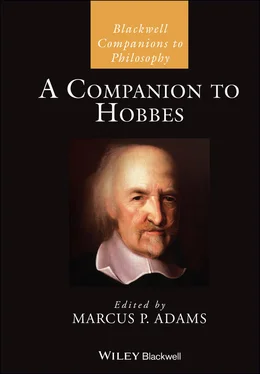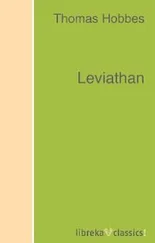(Hobbes 2012, 54; 1651, 14)
Each mental representation is still a conception – and so particularistic and imagistic – but via the symbolic medium of language, thoughts are “registered and remembered.” However, this “registering” is not a simple one-to-one mapping of a name to a conception. The consequences of thoughts – each of which is just a train of mental particulars – are registered as a universal rule, expressed in the structure of a sentence.
As Hobbes defines truth, it is a semantic property – a property of sentences (or “propositions” as Hobbes calls them):
A true proposition is that, whose predicate contains, or comprehends its subject, or whose predicate is the name of everything, of which the subject is the name; as man is a living creature is therefore a true proposition, because whatsoever is called man , the same is also called living creature ; and some man is sick , is true, because sick is the name of some man … these words true , truth , and true proposition , are equivalent to one another; for truth consists in speech, and not the things spoken of.
(EW I.35)
“True” is a metalinguistic predicate (a “name of a name” [Hobbes 2012, 1078; 1651, 372]) and applies to those sentences such that, by the imposition rules governing the names composing the sentence, the extension of the subject term is subsumed or contained within the extension of the predicate term (EW IV.23–4). The truth conditions of a sentence are given by the imposition of the component names – the application conditions that fixed the extensions of the names. Thus, the truth conditions of a sentence can be expressed as a rule of inference concerning the names involved in the sentence, capturing their proper use in cognition: The sentence “man is a living creature” is true if and only if all of the objects in the extension of “man” fall within the extension of “living creature” or, “If x is in the extension of ‘man’, then x is in the extension of ‘living creature’.”
According to Hobbes, a propositional attitude is a relation between a language-using animal and a sentence (2012, 98–100; 1651, 30–1; EW IV.2–8). To judge that a sentence of the form “S is P” is true is to accept that “If x is in the extension ‘S,’ then x is in the extension of ‘P’.” That is, propositional judgments involve grasping the truth conditions of sentences. But this implicitly involves semantic ascent, recognizing metalinguistic information expressed in the structure of the sentence; it is tantamount to acceptance of a rule for linking names to one another in reasoning. In order to grasp the truth conditions of a sentence, one must have an understanding of the imposition rules governing the use of the component names deployed in the sentence. To grasp the truth conditions of “S is P,” one must know how to use “S” and “P” as marks for thought. This, to anticipate the argument of the next section, is just what it is to “understand a name”: “to remember, by means of a name, those things which have to be considered in some matter, and for which the name has been imposed … the name ‘man’ is understood when this word brings to mind not only a human shape, but also its reasoning-capacity” (Hobbes 1976, 52).
The relationship between a language user and the sentences she judges to be true is a kind of causal relation, insofar as names play a functional role in the thought patterns of a language user. A name is a mark and, as a mark, it plays a role in the cognitive activity of the user. It causes the user, who has internalized the rule governing its application, to recall those ideas for which it was set up (Abizadeh 2015). As the buoy causes the sailors to think about the submerged rock when they see the buoy, so a name causes the person who grasps the “imposition” of the name to recall conceptions of the objects on which the name is imposed. A sentence read or heard or “tacitly thought” (EW V.197), causes a person to recall a chain of conceptions, corresponding to the impositions of the names concatenated together into the sentence. This is what Hobbes refers to as “remembering the use of names.” Conceptions are raised upon the hearing or reading of a sentence insofar as there is an associative habit to use a name as a mark for the sake of recalling conceptions. So, when I read the sentence, “red tomatoes are ripe,” the name “red tomato” causes me to think about some tomato and to selectively attend to its color. Then, there is a train of thought that takes me to various memories of ripe tomatoes, with that color. I recall that “ripe tomato” is applied to tomatoes for the sake of this gustatory appearance and judge that the sentence “red tomatoes are ripe tomatoes” is true (cf. EW I.23–4). So, while Archie and I can expect to experience the sensation ripeness from this red tomato on the basis of memory and the associative connections between conceptions, and thereby evince possession of the general concepts of tomatoes and ripeness , only I am able to grasp these concepts through a universal representation, preserved in the sentence I judge to be true. Returning to the case of the geometer, while he can see that two figures are triangles because they resemble one another in respect of having three sides (because he can selectively attend to their shape), with the use of the name “triangle” he is able to make and retain a universal judgment about all triangles, that is, everything within the extension of “triangle”. 7
5.4 Understanding Linguistic Signs
With the foregoing in mind, let us return to Hobbes’s account of understanding linguistic signs. Language-competent humans understand “words as words” because they know how to use names in sentences to register thoughts. In the first part of Elements of Law , there is another brief comment on the distinction between human and non-human animal understanding of language that helps illuminate Hobbes’s views on linguistic meaning. Knowledge necessarily involves both truth and evidence, which Hobbes defines as “the concomitance of a man’s conception with the words that signify such conception in the act of ratiocination” (EW IV. 28). Hence, someone who merely speaks the words of the propositions composing a valid syllogism – perhaps by rote, “as it is with beggars, when they say their paternoster ” (EW IV.25) – will “make always true conclusions” so long as he begins with true propositions, but he will not have knowledge of the conclusion of his syllogism, as “his conclusions [are not] evident to him, for want of the concomitance of conception with his words” (EW IV.28). Evidence, in Hobbes’s sense, is necessary for the possession of knowledge for,
[I]f the words alone were sufficient, a parrot might be taught as well to know truth, as to speak it. Evidence is to truth, as the sap to the tree, which, so far as it creepeth along with the body and branches, keepeth them alive; where it forsaketh them, they die: for this evidence, which is meaning with our words , is the life of truth.
(EW IV.28; emphasis added in second set of italics)
As I understand Hobbes’s point, although there would be formal truth-conditions for a sentence uttered by a parrot, the parrot would not be able recognize the truth-conditions of what he utters; hence, he would not understand the meaning of what he says. To understand the meaning of a sentence is to grasp the conditions under which it would be true. To know the truth-conditions of a sentence he utters, the parrot would need to know the empirical conditions for which the impositions of the component names were fixed – as Hobbes puts it in De cive , “to know a truth is the same as to remember that it was made by ourselves by the very use of names” (Hobbes 1991, 374; OL II.419). 8Hence, although Hobbes distinguishes the truth-conditions of a sentence from its verification conditions, the latter constitutes “meaning with our words” and grasping meaning is matter of knowing the application conditions of the names out of which a sentence is composed. 9
Читать дальше












